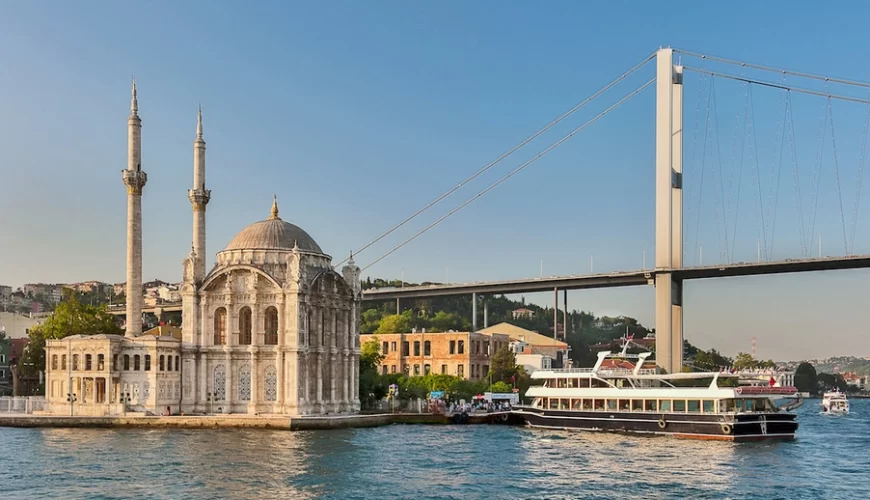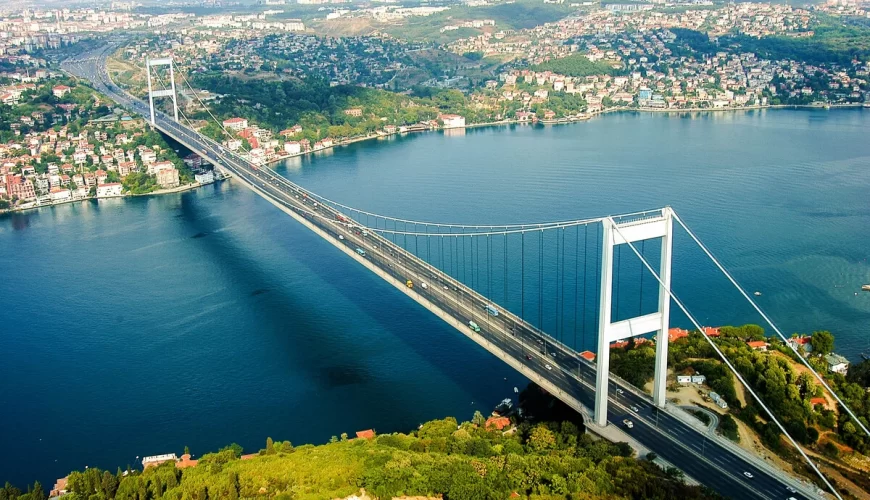Bosphorus Strait; Turkish: İstanbul Boğazı ‘Istanbul strait’, colloquially Boğaz) or Bosphorus Strait is a natural strait and an internationally significant waterway located in Istanbul in northwestern Turkey. It forms part of the continental boundary between Asia and Europe, and divides Turkey by separating Anatolia from Thrace. It is the world’s narrowest strait used for international navigation.
Most of the shores of the Bosporus Strait, except for the area to the north, are heavily settled, with the city of Istanbul’s metropolitan population of 17 million inhabitants extending inland from both banks.
The Bosporus Strait and the Dardanelles Strait at the opposite end of the Sea of Marmara are together known as the Turkish Straits.
Sections of the shore of the Bosporus in Istanbul have been reinforced with concrete or rubble and those sections of the Strait prone to deposition are periodically dredged.
The name of the strait comes from the Ancient Greek Βόσπορος (Bósporos), which was folk-, from the genitive of boûs βοῦς ‘ox, cattle’ + poros πόρος ‘passage’, thus meaning ‘cattle-passage’, or ‘cow passage’ This is a reference to the Greek mythological story of Io, who was transformed into a cow and condemned to wander the Earth until she crossed the Bosporus, where she met the Titan Prometheus, who comforted her by telling her that she would be restored to human form by Zeus and become the ancestor of the greatest of all heroes, Heracles (Hercules).
Io supposedly went ashore near Chrysopolis (present-day Üsküdar), which was named Bous ‘the Cow’. The same site was also known as Damalis (Δάμαλις), as it was where the Athenian general Chares had erected a monument to his wife Damalis, which included a colossal statue of a cow (the name δαμάλις translating to ‘heifer’).
The English spelling with -ph-, Bosphor is not justified by the ancient Greek name, and dictionaries prefer the spelling with -p- but -ph- occurs as a variant in medieval Latin (as Bosphor, and occasionally Bosphorus or Bospherus), and in medieval Greek sometimes as Βόσφορος, giving rise to the French form Bosphore, Spanish Bósforo and Russian Босфор. The 12th-century Greek scholar John Tzetzes calls it Damaliten Bosporon (after Damalis), but he also reports that in popular usage the strait was known as Prosphorion during his day, the name of the most ancient northern harbour of Constantinople. In English the preferred spelling tends to be Bosphorus.
Historically, the Bosporus was also known as the “Strait of Constantinople”, or the Thracian Bosporus to distinguish it from the Cimmerian Bosporus in Crimea. These are expressed in Herodotus’s Histories, 4.83; as Bosporus Thracius, Bosporus Thraciae, and Βόσπορος Θρᾴκιος (Bósporos Thráikios), respectively. Other names used by Herodotus to refer to the strait include Chalcedonian Bosporus (Bosporus Chalcedoniae, Βοσπορος της Χαλκηδονιης [Bosporos tes Khalkedonies], Herodotus 4.87), or Mysian Bosporus (Bosporus Mysius).
The term eventually came to be used as the common noun βόσπορος, meaning “a strait”, and was also formerly applied to the Hellespont in Classical Greek by Aeschylus and Sophocles.
The link between Oxford and Bosporus as interchangeable terms has also been highlighted by Bosporus Press, a poetry imprint based in Oxford.
As a maritime waterway, the Bosporus specifically connects the Black Sea to the Sea of Marmara and thence to the Aegean and Mediterranean seas via the Dardanelles. It also connects various seas along the Eastern Mediterranean, the Balkans, the Near East, and Western Eurasia. Thus, the Bosporus allows maritime connections from the Black Sea all the way to the Mediterranean Sea and the Atlantic Ocean via Gibraltar, and to the Indian Ocean through the Suez Canal, making it a crucial international waterway, in particular for the passage of goods coming from Russia.
There is one very small island in the Bosphorus just off Kuruçeşme. Now generally known as Galatasaray Island (Galatasaray Adası), this was given to the Armenian architect Sarkis Balyan by Sultan Abdülhamid II in 1880. The house he built on it was later demolished and the island became a walled garden and then a water sports centre before being given to the Galatsaray Sports Club, hence its name. However, in the 2010s it was completely overbuilt with nightclubs which were torn down in 2017. It reopened to the public in the summer of 2022.
The shores of the Bosphorus were once lined with small fishing villages that had grown up since Byzantine times but really came into their own in the 19th century. Until the early 20th century most were only accessible by boat (known as caiques) along the Bosporus since there were no coast roads. Today the villages are no more than suburbs of Greater Istanbul but many retain the memory of their original village status in the suffix ‘-köy (village’ to their names. e.g Ortaköy, Yeniköy, Arnavutköy, Çengelköy and Vaniköy. These villages often had distinct identities associated with agriculture: Arnavutköy, for example, was associated with strawberry-growing while Çengelköy was famous for its sweet cucumbers.
The Bosporus has 620 waterfront houses (yalı) built during the Ottoman period along the Strait’s European and Asian shorelines. Ottoman palaces such as the Topkapı Palace, Dolmabahçe Palace, Yıldız Palace, Çırağan Palace, Feriye Palaces, Beylerbeyi Palace, Küçüksu Palace, Ihlamur Palace, Hatice Sultan Palace and Adile Sultan Palace also stand on or near its shores. Other buildings and landmarks on the Bosporus include the Kılıç Egyptian Consulate at Bebek, Bebek Mosque, Boğaziçi University, Robert College, Rumeli Castle (RumelihisarI), Borusan Museum of Contemporary Art, Sakıp Sabancı Museum, Sadberk Hanım Museum, Üsküdar Mihrimah Sultan Mosque, Şemsipaşa Mosque, Maiden’s Tower (Kızkulesi), Beylerbeyi Mosque, Anadolu Castle (Anadoluhisarı), Kuleli Military High School, Adile Sultan Palace, Küçüksu Pavilion, Khedive’s Villa, Beykoz Mecidiye Pavilion and Yoros Castle (Anadaolu Kavağı).
Catamaran sea buses offer high-speed commuter services between the European and Asian shores of the Bosporus, but they stop at fewer ports and piers in comparison to the public ferries. Both the public ferries and the sea buses also provide commuter services between the Bosporus and the Prince Islands in the Sea of Marmara.
Bosphorus Tourist cruises are available from various points along the Bosporus, including Ortaköy. The prices vary considerably, and some feature music and dining.








Comment (0)